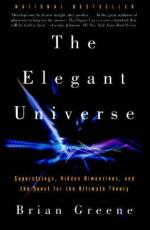
|
| Name: _________________________ | Period: ___________________ |
This test consists of 5 short answer questions, 10 short essay questions, and 1 (of 3) essay topics.
Short Answer Questions
1. Which of the following was the first string theory?
2. According to general relativity, which of the following is said to warp or bend space-time?
3. When the distance between two objects is doubled, what happens to the strength of the gravitational pull between them?
4. What would an outside observer notice about an object moving near the speed of light?
5. What is the Planck mass?
Short Essay Questions
1. Suppose that two objects are exerting a gravitational pull on each other, when one suddenly moves a large distance further away from the other object. Describe the impact of this event according to general relativity.
2. Describe the basic principles of string theory.
3. How does string theory reconcile quantum mechanics and the theory of general relativity?
4. Describe a black hole, including some of its physical properties and methods by which it can be detected.
5. Describe Max Planck's solution to the infinite-energy problem.
6. Describe the structure of an atom.
7. What are super-partners?
8. What are some of the difficulties in confirming string theory experimentally?
9. Describe some of the problems with uniting quantum mechanics and general relativity.
10. Describe the relationship between the vibration of a string and the particle it represents, including the particle's mass and the tension, wavelength, and amplitude of the string.
Essay Topics
Write an essay for ONE of the following topics:
Essay Topic 1
M for Mystery
M-theory is an as yet undiscovered theory that would unit the five fields of string theory. What the "M" stands for is actually subject to some debate, but the theory suggests that there are connections between the five seemingly disparate theories.
Part 1) Describe the origin of the five string theories, explaining why their existence is an embarrassment for the field.
Part 2) Explain the history of M-theory. When and why was it proposed, and what progress has been made since it was created? What is its current scientific status?
Part 3) Explain the concept of duality, which relates different string theories. Has this theory has any success, and what are its prospects in the future?
Essay Topic 2
The Quantum
The quantum is the smallest possible unit of energy that can be manifested for a particular fundamental force. The realization that energy came in discrete "packets" revolutionized physics and created the field of quantum mechanics. This essay is about the discovery of the quanta.
Part 1) Research and fully describe the nature of the problem of the "oven" that contains infinite energy. What were some early attempts at a solution?
Part 2) Describe Max Planck's solution to the problem in detail. How did his final approach resolve the infinite sums into finite ones? What is the relationship between the properties of the electromagnetic wave and its energy?
Part 3) Planck proposed that energy could only exist in multiples of certain minimum amounts. Describe how he came to this conclusion, and what impact this conclusion had on other fields of science.
Essay Topic 3
Time Travel through Relativity
Special relativity states that as an object's velocity increases, it moves through time more slowly. This effect is amplified greatly near the speed of light. If a ship could be built to travel close to the speed of light for an extended period, a person on that ship could return to earth many years into its future.
Part 1) Propose a mission for such a craft. What will be its goal? Will it be manned or unmanned? How many years into the future will it journey? Use special relativity to estimate how long the journey will be for the ship and its crew.
Part 2) Describe the craft and its contents in detail. What supplies, people, equipment, and other objects must it bring with it? How large is the craft, and about how much does it weigh?
Part 3) Explain contingency plans for the mission. What will happen if it arrives early, or too late? What will happen to the craft and its crew after the mission is complete?
Part 4) Guess creatively at what people will think of the craft when it arrives in the future.
|
This section contains 1,227 words (approx. 5 pages at 300 words per page) |

|




